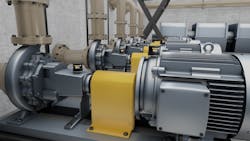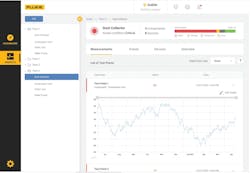Can you hear that? That’s the sound of your machine failing.
It is not a question of if a machine will fail, but when. And, by the time you hear excessive or abnormal vibration, it is likely that damage has already been done. Vibration data can indicate conditional change. Collecting and trending that data enables maintenance professionals to identify potential failures and to prevent them before downtime or damage occurs.
Monitoring assets to identify when vibration patterns change — and how much they change — can tell maintenance teams a lot about the health of a machine. The goal of vibration monitoring and analysis is not to eliminate vibration completely, because all rotating parts vibrate. Instead, the goal is to identify changes in that vibration. Excessive vibration can indicate problems and lead to premature wear of components. Once identified, changes in vibration patterns can be interpreted, and the fault behind the changes can be determined.
Route-based maintenance is time-consuming, and regularly visiting assets in hard-to-reach or dangerous areas adds risk. Vibration sensors can screen assets so maintenance teams can monitor them remotely, accessing vibration data from the sensors using a smartphone or desktop computer. By reducing their trips to assets in hard-to-reach or dangerous areas, teams stay safer and have more time to devote to the most important things.
There are sensors suitable for any asset type or budget. Some take detailed readings frequently and convey a great deal of data. Battery-less sensors, which are smaller and use less energy, take quick snapshots of asset data.
Sensors placed on machinery’s bearings can measure the vibration frequencies that are transmitted from the rotating shaft through the bearings to the surface of the machine. This data can then be transmitted from the sensor itself to software that will trend the data and allow users to analyze it. Alarms can be sent to alert maintenance teams when a machine’s condition changes. And when analysis of the data indicates a fault, maintenance teams can choose to perform further testing, gather further data or schedule a repair. This decision should consider the history of the asset, its criticality and the severity of the fault. Vibration analysis is a key piece of a condition-based maintenance strategy.
Vibration analysis as part of a condition-based maintenance (CBM) strategy
Condition-based maintenance does not wait for things to break down or determine when to perform maintenance actions based on calendar dates. Instead, condition-based maintenance involves using techniques such as vibration monitoring and analysis to hear the clues that machines are giving about their own health and performance. When machine condition changes, detecting those changes and determining their cause determines how maintenance teams should respond — and when.
Vibration analysis has been an established practice for decades. As a result of this, there are robust algorithms and rules that exist to identify and diagnose machine faults. There are characteristic patterns in vibration signals. Reading and recognizing those patterns takes extensive training and experience, but 90% of machine faults fall into four common categories: misalignment, imbalance, looseness and bearing wear. Instead of trying to learn to identify every possible fault, focus on the four most common.
Misalignment
When machine shafts are out of line, damaging forces will cause increased mechanical loads, energy waste and advanced wear on components. Worst-case scenarios can include cracked or broken shafts — not only a problem for the asset but also a potential safety hazard that puts maintenance personnel at risk.
Imbalance
A heavy spot on a shaft causes abnormal vibration when the unbalanced weight rotates around the machine’s axis, leading to increased bearing and seal wear, energy waste and poor production.
Looseness
A shaft, foundation or component can become loose, causing potentially destructive vibration and increasing the wear of bearings and seals. Looseness can also result in improper fit between components, loose bolts or baseplate problems.
Bearing wear
Excessive loads, poor lubrication or installation, or other machine faults will cause bearing wear, eventually leading to failure. Bearing rollers traveling over a worn or damaged area can cause vibration, as can a drive belt that is breaking down.
Preventing failures and unplanned downtime with vibration analysis
Vibration changes can signal when machines are not operating in peak condition and, instead, are in need of intervention or repair. Underlying causes of vibration can shorten the life of equipment and components. Finding and fixing impending faults before they cause damage or downtime means assets can be kept up and running — in peak condition — longer. This directly benefits the bottom line.
Early warnings give teams the opportunity to focus on the machines that need attention and to plan on the best time to fix failures. Moving away from a reactive maintenance strategy helps teams optimize their time and energy and increase the availability and reliability of their assets.
As a mechanical application and product specialist with Fluke Reliability, John Bernet works with customers from all industries to successfully implement their reliability programs. He has more than 30 years of experience in the maintenance and operation of commercial machinery and as a nuclear power plant electrician in the U.S. Navy. He holds a Category II Vibration Analyst certification and is a Certified Maintenance Reliability Professional (CMRP).





